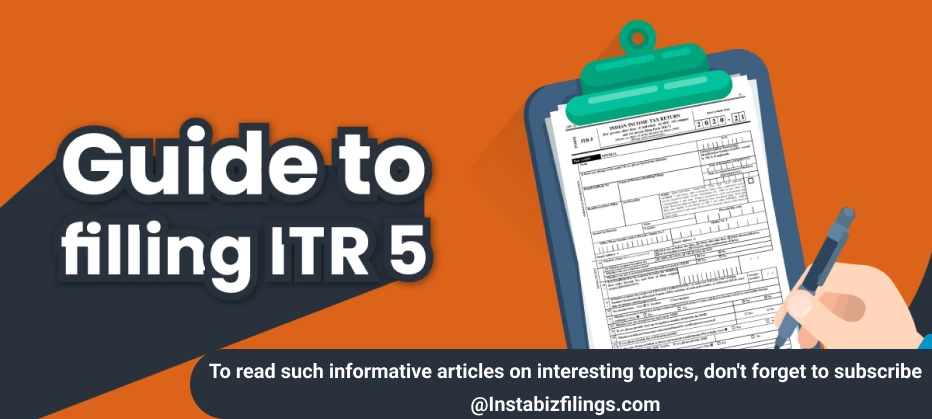
ITR-5 Return Filing
February 18, 2025 by Team Instabizfilings
What is ITR-5?
ITR-5 is an income tax return form designed for firms, Limited Liability Partnerships (LLPs), Association of Persons (AOPs), Body of Individuals (BOIs), and certain other types of taxpayers, including those who are not eligible for ITR-1, ITR-2, ITR-3, or ITR-4. ITR-5 is used for filing returns related to income earned by partnerships, firms, and certain trusts. This form is applicable to entities other than individuals, Hindu Undivided Families (HUFs), and companies.
Who Should File ITR-5?
The following entities should file ITR-5:
-
Partnership Firms (including LLPs): Any partnership firm, including limited liability partnerships (LLPs), is required to file ITR-5. This includes those involved in manufacturing, trading, or providing professional services.
-
Association of Persons (AOP) / Body of Individuals (BOI): If an AOP or BOI is engaged in activities such as income-generating operations, they must file ITR-5.
-
Limited Liability Partnerships (LLPs): LLPs are also required to file their tax returns using ITR-5, unless they are registered as a company and filing under corporate tax provisions.
-
Cooperative Societies: Cooperatives that do not opt for tax under Section 44AD, 44ADA, or 44AE and are not required to file ITR-6 will use ITR-5.
-
Trusts and Estates: Any trust (except charitable or religious trusts filing under ITR-7) or estates receiving income through trustees are also required to file ITR-5.
-
Limited Liability Partnerships (LLPs): Firms registered as LLPs with a turnover exceeding the prescribed threshold need to file ITR-5.
-
Political Parties (only if required): Political parties are required to file ITR-5 under certain circumstances.
-
Any Other Non-Corporate Entities: Entities that don’t fall under the category of individual, HUF, or company but have taxable income will use ITR-5.
Documents Required for Filing ITR-5
The following documents should be ready when filing ITR-5:
-
PAN of the Entity: The Permanent Account Number (PAN) is mandatory for all entities.
-
Income and Expenditure Statements: For firms or businesses, profit and loss accounts or income statements.
-
Balance Sheet: Required to show the entity's assets and liabilities.
-
Tax Credit Certificates (Form 26AS): If the entity has received any TDS (Tax Deducted at Source) or TCS (Tax Collected at Source) on their income, details need to be mentioned in the form.
-
Bank Statements: Essential for verifying the income of the entity.
-
Books of Accounts: For firms or businesses, books of accounts will provide information on income and deductions.
-
Partnership Deed: For partnerships, a copy of the deed outlining the relationship and terms between partners.
-
Income Details from All Sources: Income from various sources like business, profession, house property, etc.
-
Deductions Claimed (if any): Any eligible deductions under Chapter VI-A like Section 80C, 80D, etc., should be supported by relevant documents.
-
TDS Certificates: If the entity has any TDS credits.
Steps to File ITR-5
Filing ITR-5 is an online process, and here are the steps involved:
Step 1: Visit the Income Tax E-filing Portal
-
Go to the Income Tax Department’s e-filing website.
Step 2: Login to Your Account
-
Log in using the entity’s PAN and password. If it’s your first time, create an account using the PAN Card number.
Step 3: Select the Correct ITR Form
-
From the options available, choose ITR-5 as the form for filing.
Step 4: Choose the Assessment Year
-
Select the Assessment Year for which the return is being filed. This is typically the year after the financial year (e.g., for FY 2023-24, the Assessment Year is 2024-25).
Step 5: Fill Out the Income Details
-
Provide details about the income earned by the entity, including income from business, profession, or any other sources.
-
In the case of a partnership firm or LLP, report the income, deductions, and other relevant figures.
Step 6: Provide Partnership Details (if applicable)
-
If the entity is a partnership, fill in the details of the partnership firm, including the profit-sharing ratio, capital contribution of the partners, and other related data.
Step 7: Provide Tax Credit Information
-
Mention any TDS (Tax Deducted at Source) or TCS (Tax Collected at Source) credits if applicable. This can be cross-verified with the Form 26AS available on the Income Tax portal.
Step 8: Calculate and Review Tax Payable
-
The portal will automatically calculate the tax payable based on the data entered. It will show any tax deductions, tax credits, and the final payable amount.
Step 9: Submit the Return
-
Once you have reviewed all the details and ensured they are accurate, submit the return online.
Step 10: E-Verify the Return
-
After submission, you must verify the return using one of the following methods:
- Aadhaar OTP (for individual taxpayers).
- Net Banking.
- Sending signed ITR-V form to CPC Bangalore (if you can’t verify electronically).
Key Features of ITR-5
-
Applicable to Non-Corporate Entities: ITR-5 serves partnerships along with LLPs, AOPs, BOIs and trusts through its designated framework for non-corporate entities.
-
Comprehensive Income Details: The form requests complete details about business income together with professional revenue and all other source incomes.
-
Tax Credit Integration: Businesses can simplify their tax credit adjustments via Form 26AS because the application integrates TDS/TCS information.
-
Business Deduction Reporting: The Internal Revenue Service allows businesses to claim deductions that involve depreciation expenses and interest payments as part of their business operations.
-
Tax Filing for Trusts and Estates: The system enables the trustee-controlled income filing process for trusts and estates to follow.
Benefits of Filing ITR-5
-
Accurate Tax Calculation: Entities generating income from business and profession or through additional activities can maintain accurate tax calculation by filing ITR-5.
-
Avoid Penalties: Businesses that file their ITR-5 in time can prevent both penalties and late submission interest payments.
-
Claiming Deductions: The system enables business entities to subtract different allowable expenses which minimizes their total taxable revenue and thus decreases their tax bill.
-
Transparency in Business Operations: Tax authorities maintain good standing while achieving transparency because companies use ITR-5 for their tax return filings.
-
Enhanced Creditworthiness: The practice of regular return filing improves business trustworthiness because it enables entities to secure future credit possibilities and loans.
Common Mistakes to Avoid While Filing ITR-5
-
Incorrect Income Declaration: Verify that the reported income contains an exact representation of all profit streams from partnership interests along with business revenues along with other taxable earnings.
-
Failure to Include All Partners: When filing as a partnership or LLP maintain complete details about all partners who must include their profit-sharing information and their capital amounts.
-
Non-compliance with Tax Deduction Clauses: Any TDS deduction process should result in showing correct TDS information obtained from Form 26AS in the return.
-
Missing Tax Credit: Check that all tax credits particularly advance tax and TDS meet their correct application criteria to prevent any kind of underpayment.
-
Late Filing: The delay in filing the tax return before its deadline causes penalties alongside interest to apply. Given consequences can be prevented by timely filing of documents.
Deadline for Filing ITR-5
The deadline for filing ITR-5 typically follows the same as the regular tax filing deadline of 31st July of the assessment year, unless extended by the Income Tax Department. However, if the entity is required to undergo a tax audit, the deadline may be extended to 30th September.
Conclusion
Filing ITR-5 is an essential process for firms, LLPs, AOPs, BOIs, and trusts. It ensures compliance with tax laws while providing entities with an opportunity to claim deductions, apply tax credits, and accurately calculate their tax liabilities. By following the correct process, entities can ensure a smooth filing experience and avoid penalties or audits.
Disclaimer
The information provided in this blog is purely for general informational purposes only. While every effort has been made to ensure the accuracy, reliability and completeness of the content presented, we make no representations or warranties of any kind, express or implied, for the same.
We expressly disclaim any and all liability for any loss, damage or injury arising from or in connection with the use of or reliance on this information. This includes, but is not limited to, any direct, indirect, incidental, consequential or punitive damage.
Further, we reserve the right to make changes to the content at any time without prior notice. For specific advice tailored to your situation, we request you to get in touch with us.


